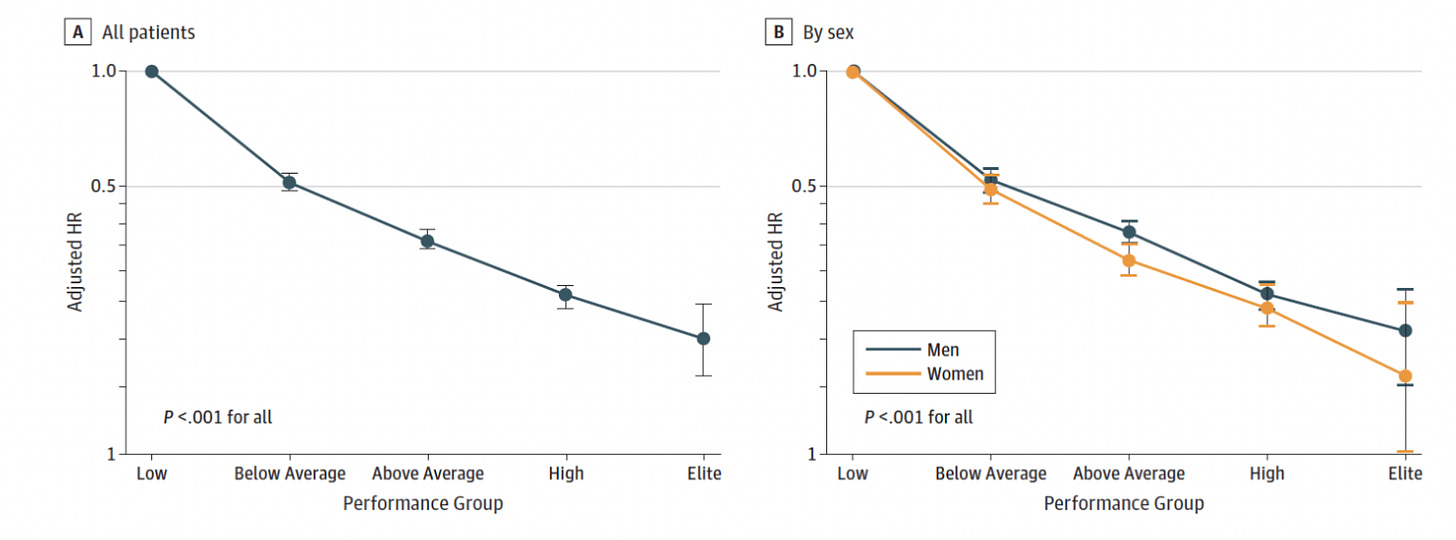Today I’m sharing the basic framework I’ll use to approach healthspan. Creatively, I’ve named it the Healthspan Framework 😉. I’m also going to explain why I’m personally starting with a focus on physical fitness and exercise.
Keeping sight of the big picture
Opinions abound about what will improve your health, especially on the internet. It’s easy to get lost down a rabbit hole - fasting, supplements, mindfulness, microplastics, processed foods, electromagnetic radiation, you name it.
The idea of the Healthspan Framework is to set out the most important factors, so we can keep sight of the big picture and take a reasonably comprehensive and balanced path forward.
There’s an ever growing body of science-backed resources to help us understand our healthspan and I’ll be aiming to share the best ones I find here in Extend. One that’s influenced me recently is Dr Peter Attia’s book Outlive: The Science and Art of Longevity. One of the foremost experts in the field, Dr Attia combines the relevant science with his extensive clinical experience in preventative medicine to put forward a strategic approach to health and longevity. Outlive is easily my most recommended book of the past year and is what I’ve primarily leaned on for the Healthspan Framework.
The framework
At the most basic, a the Healthspan Framework is intended to support:
Understanding and measuring where we stand today - our “Healthspan Status”
Applying practices aimed at improving Healthspan Status, informed by step 1. These relate to exercise, nutrition, sleep, and mental and emotional health
Repetition. Periodic measurement and ongoing work will be needed for a lifetime as our practices move us forward, ageing processes push back, and science and technology keep evolving.
So with that, I present to you the Healthspan Framework. It sets out the key things we’ll explore to better understand our Healthspan Status and the pillars of practice that can help us extend.
A few things about the Healthspan Framework and applying it:
Depending on how you look at it, it’s both oversimplified and complex. Reality doesn’t fit exactly within a framework or a box. We get that.
Perhaps it looks like a lot or parts seem confronting. Don’t let overwhelm or fear get the better of you. While I wouldn’t advise completely ignoring any part of the framework, always remember:
Something is better than nothing. You don’t have to tackle everything immediately
It’s not about being perfect or eliminating fun. If it was I certainly wouldn’t be here!
You have choices about what you wish to find out. For me, knowledge is power when it comes to my health. For others, there are things they’d rather not know.
My approach will be non-linear and non-sequential. If I waited to understand everything I could about my Healthspan Status before moving onto practices, I’d be dead before I even started. Expect me to bounce around parts of the framework as we go forward.
There’s nothing revolutionary here. Again, lots of credit to Peter Attia - the pillars of practice mostly reflect the way he’s organised his book.
Why I’m starting with fitness and exercise
“Exercise is the most powerful longevity drug there is” - Dr Peter Attia
“If you could pill up what you could do with vigorous exercise, then I think that is … the best longevity drug we have for delaying the aging process and improving healthspan”
- Dr Rhonda Patrick
We all know that exercise is good for us. But I was surprised to learn that exercise is the single biggest lever that we have to pull when it comes to extending health- and lifespan. Being unfit is actually worse for your healthspan than smoking.
As we’ve identified in the Healthspan Framework, there is more than one dimension to fitness. Cardiorespiratory fitness, strength, and mobility (balance, stability, flexibility) are all relevant and we’ll go deeper into each in due course. For now, I want to highlight:
Cardiorespiratory fitness level is perhaps the single most significant indicator for longevity1
Strength and muscle mass are similarly very highly correlated with longevity.2
Put simply, the fitter you are, the longer you are likely to live.

The less fit you are, the bigger the opportunity you have to dramatically improve your prospects through exercise. If you’re already quite fit, maintaining and improving your fitness level is absolutely worthwhile.
Exercise is accessible to virtually all of us. In addition to supporting our fitness and mood, the act of exercising reinforces a powerful identity - “I am a healthy person. I prioritise my health.”
On that note, in my next post I’ll tell you about my experience in measuring my cardiorespiratory fitness through testing for one of the most favoured measurements, called VO2 max.
XX Toni
As cited in Attia: Mandsanger et al. (2018), Association of cardiorespiratory fitness with long-term mortality amongst adults undergoing exercise treadmill testing. Kokkinos et al. (2022), Cardiorespiratory Fitness and Mortality Risk Across the Spectra of Age, Race, and Sex.
Li et al (2018), Associations of muscle mass and strength with all-cause mortality among US older adults (a meta analysis of studies that included studies of women)






Hi Toni, I’m halfway through Attila’s book. Keen to know more about where to measure V02max in Wellington. And if any clinics are doing Attila’s full spectrum blood lipid assessments?
That last chart is fascinating. The insight I get from seeing the large error bands on the elite datapoint is that the marginal improvement you get from shifting from a High to Elite may be negligible. You don’t need to be an elite athlete to get the vast majority of the longevity benefits!